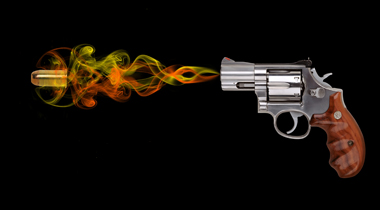UAlbany Chemists Offer Law Enforcement and Forensics New Crime Solving Tool
Method Analyzes Gunshot Residue, Pinpoints Weapon Caliber
ALBANY, N.Y. (June 18, 2012) -- University at Albany researchers have developed a method to determine the caliber and type of weapon used in a crime by analyzing gunshot residue (GSR). Using near-infrared (NIR) Raman microspectroscopy and advanced statistics, the new technique may play a pivotal role in law enforcement cases and forensic investigations. The research was highlighted in a recent issue of Analytical Chemistry.Gunshot residue comprises particles from the parts of the ammunition and firearm that explode or reside near points of explosion including the primer, propellant, and tiny particles of the cartridge case and gun itself. Since residue can be recovered from several locations in the crime scene, it may be utilized for both physical and chemical evidence: GSR establishes that the shooting took place and a person participated in the shooting.
"If a crime is committed that involves a gun, we can examine the gunshot residue to help determine the size and type of ammunition used," said UAlbany professor of chemistry and lead researcher Igor Lednev. “Then through comparisons and elimination, it is quite likely to determine what kind of a gun was used in the crime."
 |
|
UAlbany researchers analyze gunshot residue to determine the caliber and type of weapon used in a crime. |
Lednev, a member of the White House Subcommittee on Forensic Science, explained, “In the absence of a weapon and discernible ammunition remainders at a crime scene, the ability to analyze and positively identify ammunition and firearms would have a significant impact on the efficiency of a criminal investigation.”
The research team combined GSR with Raman spectroscopy, in which laser light of a specific wavelength is shined on a sample, sending its molecules vibrating. Well-suited for forensic analysis, spectroscopy does not destroy evidence, requires limited sample preparation, and has a range of applications including the identification of explosives, paint, textile dyes, drugs, and bodily fluids.
Lednev concludes that more analysis is needed before CSI teams employ the method in a courtroom. One day, investigators might even be able to flip through a database of Raman spectra of different ammunitions to more quickly link that crime-scene residue to a specific kind of gun.
Read details about Lednev’s forensic expertise or explore UAlbany's Chemistry Department. For more UAlbany news, visit the News Center.
![]() For more news, subscribe to UAlbany's RSS headline feeds
For more news, subscribe to UAlbany's RSS headline feeds
A comprehensive public research university, the University at Albany-SUNY offers more than 120 undergraduate majors and minors and 125 master's, doctoral and graduate certificate programs. UAlbany is a leader among all New York State colleges and universities in such diverse fields as atmospheric and environmental sciences, business, education, public health,health sciences, criminal justice, emergency preparedness, engineering and applied sciences, informatics, public administration, social welfare and sociology, taught by an extensive roster of faculty experts. It also offers expanded academic and research opportunities for students through an affiliation with Albany Law School. With a curriculum enhanced by 600 study-abroad opportunities, UAlbany launches great careers.


